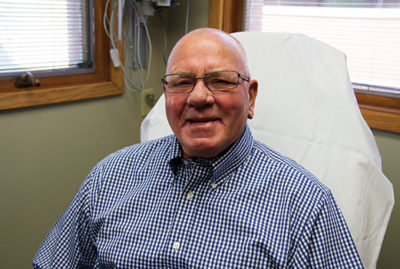
Saving Legs and Lives
By Brandon Grammar
Over a decade ago, Columbia native Donald Burkhalter was tending to routine yard work. What happened next would change the course of his everyday life.
[EasyDNNGallery|761|Width|200|Height|200|position||resizecrop|False|lightbox|False|title|False|description|False|redirection|False|LinkText||]
“I was mowing grass and I stepped on a shingle nail,” Donald says. “I’m diabetic, so I didn’t have any feeling in my feet. I didn’t know I had any injury at all. After I got through mowing, when I took my shoe off, the tip of the nail had gone into the foot. It had done quite a bit of damage.”
Donald went to his physician, who treated the wound. While it initially healed over, complications soon arose. The wound reopened several times and infection struck. A major obstacle to Donald’s healing was peripheral artery disease, or PAD, which is a common circulatory issue caused by the accumulation of plaque in the leg arteries.
Despite years of treatment, Donald’s wound refused to completely heal. Eventually, Donald couldn’t put his full weight on his foot, and he was experiencing enough pain that it caused a significant limp.
Enter the Boone Hospital Wound Healing Center, or WHC. Amy Bierk, WHC Program Director, says Donald’s scenario is typical of the patients they frequently treat. “I would say 75 percent of our patients are diabetic, and I would say 50 percent of those patients have peripheral artery disease,” says Amy. “We want to make sure that those patients out there know that we’re here.”
WHC offers its patients hyperbaric oxygen therapy and a plethora of additional advanced modalities. The clinic treated Donald’s PAD through surgery that opened the vessels in his leg and increased his blood flow. From there, a steady regiment of good wound care, managing his diabetes, offloading and 60 total hyperbaric oxygen treatments set Donald on the track to complete recovery.
Had he not been referred to WHC, there was a very real possibility that Donald would have required serious amputation. WHC has teamed up with national non-profit Save a Leg Save a Life Foundation, or SALSAL, to increase public awareness and avoid more unnecessary amputations.
SALSAL employee Carol Barry says the aftereffects of amputation are quite severe. “Say you get a partial amputation,” says Carol. “Within two years you probably get another one. Within five years, the statistics are that you die. You don’t want to lose any portion of a foot or a foot or a limb.”
Tackling public awareness has been WHC’s primary hurdle. The clinic encourages its patients to take the time to educate themselves, providing them with a means to do so by holding community screenings, posting radio and television ads, and reserving booths at community events such as the Mature Living Festival.
What makes the clinic’s goal of community education especially challenging is the fact that the knowledge gap extends beyond the general public. Oftentimes, patients in need are trapped in various stages of their healing process because of a lack of awareness within the medical community.
“I would love to have a megaphone and ride through the streets going ‘Are you aware? Are you aware?’,” says Carol.
For signs that community awareness is trending in the right direction, look no further than Donald. The wound clinic is the reason he’s walking today virtually pain-free.
“The end of the rainbow is nowhere in sight because I’m still walking on the rainbow,” says Donald. “I just very much appreciate it, myself and my entire family. If that infection had continued…people mention ‘My aunt lost her entire leg.’ You know the different stories. This is one of the success stories.”